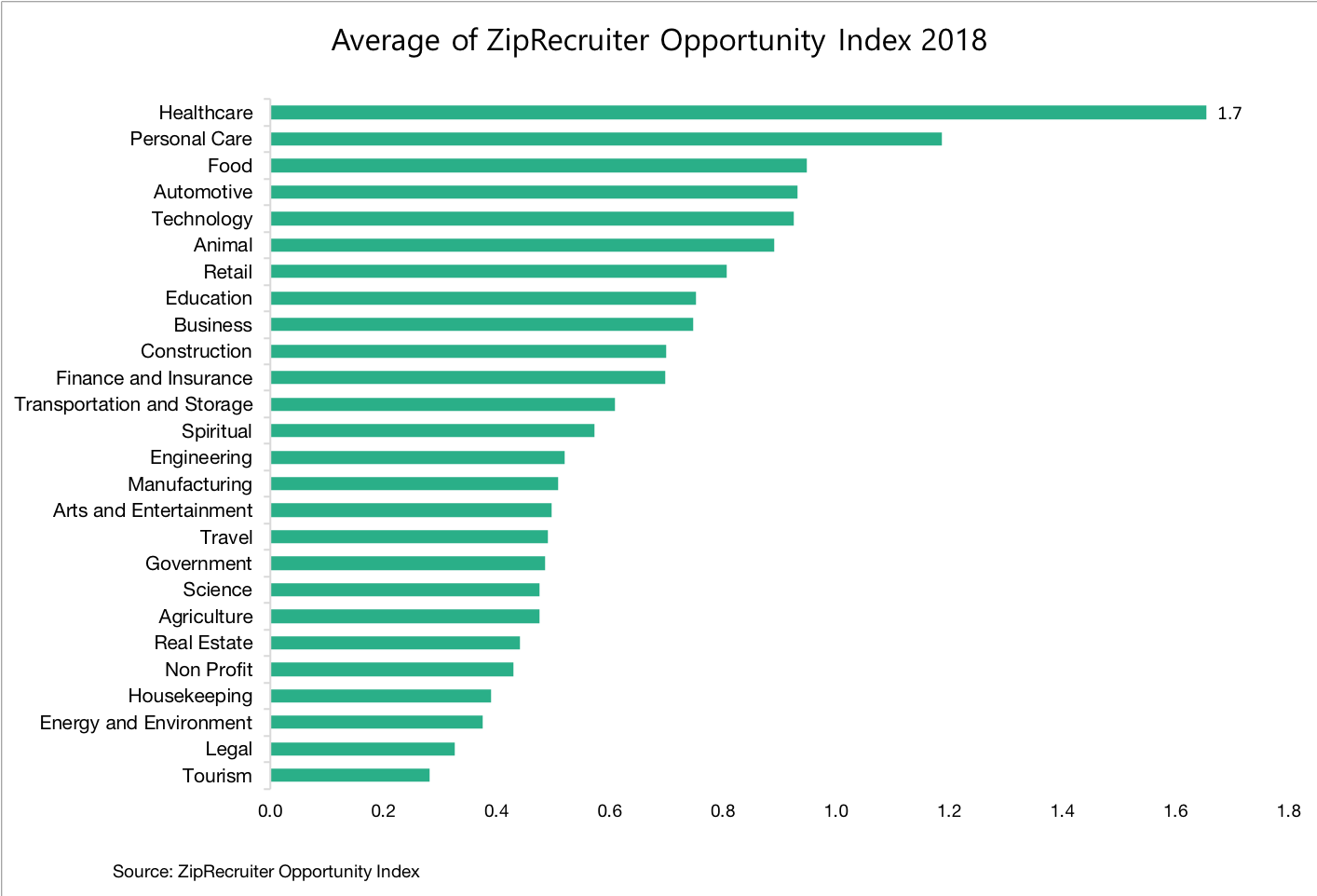Article by ZipRecruiter
2018 was definitely a year for the job market record books. The unemployment rate hit 3.7% in September, which was the lowest it has been in half a century. In April, the Bureau of Labor Statistics (BLS) reported there were more job openings in the U.S. than people out of work. Wages finally budged in October, breaking 3% growth for the first time in nine years. These are all newsworthy job market trends to be sure.
However, these are all data points you can get anywhere. With more than 8 million active job postings on the ZipRecruiter marketplace each month, we’re able to dive even deeper into what defined the job market in 2018.
These are the jobs, cities, skills, and trends that made 2018 such a fantastic year to be a job seeker.
The Top Industry of 2018: Healthcare
In our capitalist economy, where consumption is king and everything is measured in dollars and cents, it’s not surprising that the greatest share of jobs posted to ZipRecruiter each year has tended to be in sales. Not so in 2018.
No doubt thanks to the greying of the population, 15% of the 20 million+ jobs posted to ZipRecruiter in 2018 were in the healthcare industry, thus making up the greatest share of all jobs posted on our marketplace this year.
Throughout the year, there was an average of 1.7 available healthcare jobs for every applicant, nationwide. The Buffalo-Niagara Falls metro area in New York had the highest average level of opportunity for healthcare workers in 2018, with 17 healthcare job openings for every applicant.
Not only was Registered Nurse the most popular job title in the healthcare industry in 2018, but it was also the second most popular job on ZipRecruiter all year after Sales Representative.
The Best Job Market in 2018: Pittsburgh, PA
When it comes to job opportunity in 2018, the Steel City is tops. Of the top 50 metro areas by population in the U.S., Pittsburgh had the highest average number of job openings compared to job seekers in 2018.
There were 2.7 jobs for each applicant on average in Pittsburgh in every industry combined. Not only did Pittsburgh have the highest average opportunity level across the board, it also ranked highest among the top 50 metros for quality of life in our best jobs market index, which includes commute time, walkability, access to public transit, housing affordability, and health factors such as hospital beds per capita and the obesity rate.
One reason for Pittsburgh’s thriving jobs market is that it has remained on the cutting edge of high-tech. Home to Uber’s Advanced Technologies Group and the Robotics Learning Laboratory at Carnegie Mellon, the city has become ground zero for advances in autonomous vehicle technology. Our data show it has the most openings for autonomous car jobs of any metro area and it boasts an average of 1.5 tech jobs per applicant in 2018.
Jobs of the Future Take Flight in 2018
We’ve been tracking technologically induced job creation, such as jobs working with drones, autonomous vehicles, and influencer marketing since 2017. While each of these jobs was just coming on the scene two years ago, 2018 marked the year where they really took off.
From January 2017, when a few hundred autonomous car jobs were posted to ZipRecruiter each month, to November 2018, when thousands began appearing on our site, autonomous car jobs have increased 594% and have seen double- or triple-digit annual percentage increases every month this year.
While Pittsburg is the clear leader for AVs, Ann Arbor Michigan is not far behind. One-in-five AV jobs posted to ZipRecruiter in 2018 were located in Ann Arbor, Michigan, while one-in-four were located in Pittsburgh.
Drone jobs also soared in 2018, increasing 275% year over year in November. Unlike with autonomous cars, drone jobs can be found all over the U.S. Los Angeles was the top metro for drone jobs in 2018, overtaking San Francisco, which was drone mecca in 2017. The City by the Bay is still host to plenty of drone jobs, however, along with Minneapolis, Chicago, and Boston rounding out the top five.
Not all jobs of the future deal in robotics. Social media has been a presence in our daily lives for over a decade now, but 2018 was clearly the inflection point for social media-powered job creation.
While traditional advertising jobs declined in 2018, social media jobs showed steady growth. We compared job growth within the business marketing sector between all job titles related to advertising and all titles related to social media. In 2018 year-to-date, social media jobs increased 5% where traditional advertising jobs actually declined 63% as of November.
Clearly the reach, engagement, and cost-effectiveness of social media have made it the key driver for job creation in marketing and business development.
Looking Forward to 2019
Yes, overall 2018 was a year of job creation, innovation, and an abundance of opportunity for the American job seeker. But that doesn’t mean it was without its challenges.
While it may have been the year of the job seeker, employers struggled to find talent to fill open positions. This gives applicants a competitive advantage but threatens the sustained success of businesses that are trying to grow.
Labor shortages ran the gamut from entry-level, blue-collar jobs in construction, to high-skilled work in technology and healthcare. Some metro areas were hit harder than others. We’ve watched as the booming economy has led many businesses to expand in small and mid-sized cities across the South and Midwest, creating opportunities where there is simply insufficient talent to seize it.
ZipRecruiter research has shown small and medium businesses (SMBs) may be suffering the most. As big companies get bigger, they appear to have created their own gravitational pull, capturing an increasingly larger share of applicants in the latter half of 2018 than SMBs in nearly every industry.
Time will tell if these asymmetries will find equilibrium in the coming year. But we do know that the best job market is a diverse job market. With fintech jobs booming in the south, lucrative green energy jobs cropping up in the midwest, wages beginning to rise, and small, medium, and large businesses continuing to create new jobs, industry is holding up its end of the bargain. In 2019 it will be up to job seekers to get more training, negotiate for even higher salaries, and maybe even move to a different city to find their next great opportunity.
Don’t forget to follow us:





